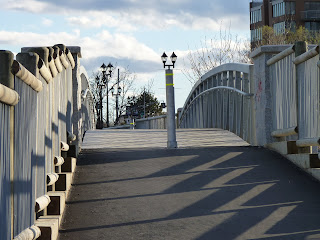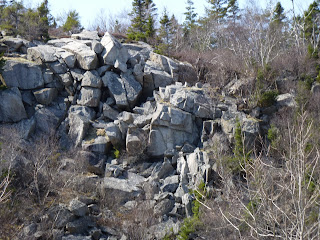We finished getting the boat ready for the storm last night. Now it's the day of the storm, and Earl is coming ashore as a category 1 hurricane, somewhere around Lunenberg. Our apartment is sheltered - the building is an ell, and much of the time the wind and rain don't affect us. We're waiting for the storm.

8:30 am: Weather: the wind is gusting, it’s foggy out. The air is still warm and humid, after a hot week. It rained last night, and the advertising that always comes off the board over the pizza store started coming off. Now it’s peeling down at the corner, and by tonight it will be gone... Web cams seem a good way to see what's happening, but most of the web cams don’t seem to be working. Our view of the storm will be confined to what we can see from our windows.
Here's what we see. In the Narrows the white caps are just starting, and there is spray where they break on the shore on the Dartmouth side. Small birds have been flying around, sudden rushes of small winged creatures and some things - leaves, paper - are starting to blow around.


9:15 am: The rain is heavy, and blowing sideways. The Narrows are hard to see now, the tree branches are dancing around, the rain is blowing past in gusts. Our windows are still gapped to let fresh air in, very slightly, but not likely to remain so much longer. Ironically, there is more traffic on the road now than there was earlier. Wonder where they’re going, and why?
CBC is checking around the province - power out in various places - mixed weather all over the place, but wind picking up. Power just flicked off and on - if it happens again, time to turn the computers off.


9:45 am: The power flicked off and on again, so I closed down the computer for the duration of the storm. Better not to risk the possible consequences of a power surge.
The rain has eased for now. The wind is blowing the leaves off the trees behind the apartment building, and they are swirling over the roof and down in front of our window. We can see the gulls gathered on the ground by the cove down the street from us, where they are well-sheltered from the wind and waves. The wind is strong enough to make the sign for our apartment building pump in and out...

10:23 am: The wind is gusting hard, and the rain is blowing sideways, in curtains, in the gusts. We are under a hurricane watch, not a tropical storm watch, thanks to the change in Earl’s course which is bringing the storm much closer to us than forecast earlier. The storm is coming ashore close to Mahone Bay, instead of further west. There are reports from Peggy’s Cove that the waves are very heavy, and in spite of the efforts of the police some foolish people have found their way out on to the rocks.


11:11 am: The wind is picking up. The electrical wires running along the road are moving. There are lights flashing by the Narrows, down by the railroad tracks, but we can’t see what is there. The trees are bending, and the advertising boards we can see from our window are moving, waving back and forth around their axes. The board that always loses it’s ad is doing what it usually does - most of the ad that was there has been washed and blown away. Reports on CBC say that the waves along the coast are building; that some sailboats have moved their moorings and drifted, and one that was moored on the LaHave River has been seen moving out to sea.
We can’t see the Narrows any more, never mind seeing across them; what we can see is the wind gusts driving the rain. Small branches are blowing along the road now, and a few bags of garbage. Every now and then CBC fades and comes back; the power flickers occasionally, but it keeps coming back on.


Noon: The rain is blowing in visible gusts. The trees by the bottom parking lot, which until now were sheltered a little bit by the building, are dancing, showing the underside of their leaves and bending and nodding in the wind. The wind looks as if it is picking up spray off the waters in the Narrows, and in the cove where the gulls are sheltering; the bridge across the Narrows which we can usually see, is invisible for now. There are reports of lots of trees down throughout Halifax.


12:12 pm: The rain is streaming so hard down the windows that it’s hard to see through them. The forecasters say it will be another hour or two until the worst part of the storm passes. The wind is gusting over 90 km/h, Earl has lost a little bit of it’s ferocity since coming ashore. Leaves and small branches are flying, swirling in the air and on the ground. People are driving past - going some place they don’t need to go?

12:50 pm: The wind is gusting in excess of 100 km/h, but the sky is growing lighter and we can see the Narrows again. We can also see that the gulls are still firmly planted on the ground.


1:24 pm: The skies are continuing to grow lighter. The wind has come around and is out of the SW, and is blowing hard against our windows. There are reports of lots of boats dragging in the Bedford Basin, at the top of the harbour above the Narrows, in the mooring field around the Bedford Basin Yacht Club. The wet flags on the roof below our windows are blowing hard now, flapping and making lots of noise.

2:15 pm: The skies are growing lighter still, and now there are a few birds in the air. The electric wires and the trees are still dancing in the wind. One small tree is leaning over into the parking lot of the aesthetics school across the road. Some of the shingles on the side of the apartment building, on what looks like alcoves, are lifting in the wind. The ads on the board above the pizza shop beside us are completely gone, and something is flapping around on the front of the store. People are starting to come out and look around, to see what has happened.

2:22 pm: A glimpse of the sun! Low clouds are moving past very quickly, but the weather is definitely lifting now.

2:44 pm: There is more and more blue sky and the clouds are higher. The wind is still blowing hard out of the SW, but the sun is shining. The storm is passing; tomorrow, except for the clean up, it will be as if it had not been here.

We stayed home for the rest of the day, though we were itching to go and see how Into The Blue had fared. We knew that there were many trees down, and some roads were blocked, and nothing was going to change between that afternoon and the next morning as far as the boat was concerned. The roads, however, should be clearer.
When we did go to the marina the next morning we found some of the traffic lights out along the way, piles of tree branches and bits by the road, and crews out working to restore power and clean up where they could. We got to the marina before the electricity did, and found Into The Blue, thankfully, just as we had left her - and, so far as we could tell, all the other boats there were fine as well. While we were there some boats started returning from where they had hidden from the storm, up the North West Arm, and some that had been hauled were being put back in the water.










